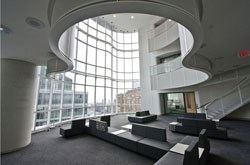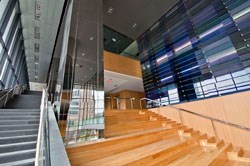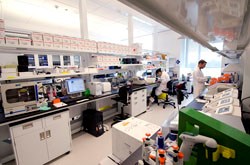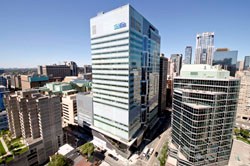The Gilgan Centre turns two!
Summary:
The Peter Gilgan Centre for Research and Learning (Gilgan Centre) at SickKids is celebrating its two-year anniversary and we’re excited to share all the amazing progress we’ve made!
By Rubab Abid
The Peter Gilgan Centre for Research and Learning (Gilgan Centre) at SickKids is celebrating its two-year anniversary and we’re excited to share all the amazing progress we’ve made!

Since marking its grand opening on Sept. 17, 2013, the Gilgan Centre’s world class facilities have been a beacon for top-notch child health research, enhancing SickKids’ appeal to international researchers and trainees alike.
The $400-million research and learning tower was a collaborative project financed with the help of our lead donor Peter Gilgan, the municipal, provincial and federal governments, and more than 13,000 donors and corporate partners. We are proud to say that the expansive 21-storey facility was completed both on time and on budget. The tower was also the first step in a larger facilities plan for the SickKids campus; following on the success of the Gilgan Centre, SickKids is currently developing a patient care facilities plan that will ensure we can continue to provide flexible, efficient, patient and family-centred care and continue to lead in paediatric health care for the next generation.
A Collaborative Space

Prior to the opening of the Gilgan Centre, SickKids research staff were scattered across six buildings. Now all under one roof in this open-concept environment, the building’s unique design aims to promote collaboration among researchers and clinicians and spark new interactions between scientists across different fields of study.
With over 750,000 square-feet of space, 2,000 SickKids scientists, staff and trainees, and 210 high-tech labs, the Gilgan Centre is always bustling with activity. The common “water cooler” areas provide scientists, clinicians and students with a space to gather and incubate new solutions for understanding and treating childhood diseases. This is critical for translating research discovery into clinical impact.
Research Milestones

The tower has also been influential in drawing world-class scientific talent to SickKids.
Over the past two years, researchers at the Gilgan Centre have led the charge within the field of paediatric research, announcing several key scientific findings and studies.
Earlier this year, Dr. Jonathan Wasserman and his team of researchers in the Genetic & Genomic Medicine neighbourhood led one of the largest genetic analyses of children with adrenocortical cancer, a rare form of cancer that affects the adrenal glands. SickKids researchers were able to analyze the gene that suppresses tumour formation in the body and use that data to determine how cancer develops in children.
In March 2015, research conducted under Dr. Brent Derry in the Cancer and Stem Cell Biology Neighbourhood led to new potential drug therapies for children with cerebral cavernous malformation (CCM) – an “undruggable” disease caused by the growth of large lesions in blood vessels found in the brain and spinal cord. By analyzing the gene linked to the early onset of CCM, researchers were able to screen for small compounds that could effectively correct defects in CCM mutant genes.

In May 2015, a study conducted by Dr. John Rubenstein and his colleagues from the Molecules, Cells and Therapies Neighbourhood successfully uncovered the function of a critical enzyme known as V-ATPase. The enzyme, a proton pump responsible for controlling the internal pH of cells, is vital for cell function and helps to regulate crucial chemical processes in the brain, heart and kidneys.
More recently, researched conducted by Dr. Stephen Scherer and his team in The Centre for Applied Genomics shed new light on the cause of cerebral palsy among children. As part of a joint study with McGill University, researchers conducted genetic testing on children with cerebral palsy and found that 10 per cent of these children had structural alterations to their DNA that may result in cerebral palsy. Based on these findings, researchers suggest incorporating genetic analyses as part of the standard of practice for diagnostic assessment of cerebral palsy.
Fun Facts
- The Gilgan Centre a LEED® certified building, a significant accomplishment for a laboratory environment.
- The Gilgan Centre stands at a height of 119 metres
- The building is made of 140,000 tonnes of glass, concrete and steel
- Contains 12,125 glass panes and 4,500 zinc panels
- The project required 3,900 trucks just to deliver the concrete
- The facility has more than 150 bicycle parking spots and three electric car outlets
Thank You!
Through the work of our dedicated researchers and scientists, the Gilgan Centre has helped firmly root SickKids as a world leader in children’s health. This new building has thrust SickKids into a new era that is already beginning to transform the way our clinicians and scientists approach the advancement of child health research, education and care.
As we continue to plan for the future, we want to thank you for continued support to help us ensure that the SickKids of the future meets the needs of our patients, families and staff.
Watch the video from the grand opening of the PGCRL:

